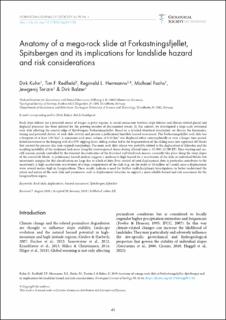| dc.contributor.author | Kuhn, Dirk | |
| dc.contributor.author | Redfield, Thomas Fitzmaurice | |
| dc.contributor.author | Hermanns, Reginald | |
| dc.contributor.author | Fuchs, Michael | |
| dc.contributor.author | Torizin, Jewgenij | |
| dc.contributor.author | Balzer, Dirk | |
| dc.date.accessioned | 2022-05-03T08:56:52Z | |
| dc.date.available | 2022-05-03T08:56:52Z | |
| dc.date.created | 2019-09-05T12:24:16Z | |
| dc.date.issued | 2019 | |
| dc.identifier.citation | Norwegian Journal of Geology. 2019, 99 (1), 1-21. | en_US |
| dc.identifier.issn | 2387-5844 | |
| dc.identifier.uri | https://hdl.handle.net/11250/2993803 | |
| dc.description.abstract | Rock slope failures are a potential source of danger in polar regions. A causal connection between slope failures and climate-related glacial and deglacial processes has been inferred for the growing number of documented events. In this context, we investigated a large-scale rotational rock slide affecting the coastal ridge of Spitsbergen’s Forkastningsfjellet. Based on a detailed structural description, we discuss the kinematics, timing and potential drivers of rock slide activity and present a preliminary landslide hazard assessment. The Forkastningsfjellet rock slide has a footprint of at least 2.03 km². A minimum rock mass volume of 0.10 km³ was displaced either catastrophically or over a longer time period. Initial movement in the hanging wall of a NW-dipping listric sliding surface led to the fragmentation of the sliding mass into separated tilt blocks that created the present-day, stair-stepped morphology. The main rock slide release was probably related to the deglaciation of Isfjorden and the resulting instability of the weakened rock mass along the oversteepened slopes during Allerød times (~13,900–12,700 BP). Mass wasting and seacliff erosion, mainly controlled by the inherent discontinuities of the fractured and tilted rock masses, currently take place along the steep slopes of the coastal tilt blocks. A preliminary hazard analysis suggests a medium to high hazard for a reactivation of the slide or individual blocks, but uncertainty margins for this classification are large due to a lack of data. Poor control of total displacement data in particular contributes to the uncertainty. A high-acceleration reactivation of a large compartment of the slide (e.g., on the order of 10 million m3) could cause a displacement wave several metres high in Longyearbyen. These results indicate a need for further multidisciplinary investigations to better understand the extent and nature of the rock slide and parameters such as displacement velocities to support a more reliable hazard and risk assessment for the Longyearbyen region. | en_US |
| dc.language.iso | eng | en_US |
| dc.publisher | Norsk Geologisk Forening | en_US |
| dc.rights | Navngivelse 4.0 Internasjonal | * |
| dc.rights.uri | http://creativecommons.org/licenses/by/4.0/deed.no | * |
| dc.title | Anatomy of a mega-rock slide at Forkastningsfjellet, Spitsbergen and its implications for landslide hazard and risk considerations | en_US |
| dc.title.alternative | Anatomy of a mega-rock slide at Forkastningsfjellet, Spitsbergen and its implications for landslide hazard and risk considerations | en_US |
| dc.type | Peer reviewed | en_US |
| dc.type | Journal article | en_US |
| dc.description.version | publishedVersion | en_US |
| dc.source.pagenumber | 1-21 | en_US |
| dc.source.volume | 99 | en_US |
| dc.source.journal | Norwegian Journal of Geology | en_US |
| dc.source.issue | 1 | en_US |
| dc.identifier.doi | 10.17850/njg99-1-03 | |
| dc.identifier.cristin | 1721879 | |
| cristin.ispublished | true | |
| cristin.fulltext | original | |
| cristin.qualitycode | 1 | |

